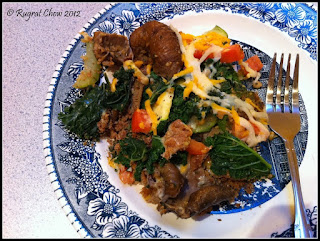Growing up, we ate a lot of Chinese food from this little shack which was just a couple of miles from our house. I don't even remember what it was called anymore. Indo-Chinese cooking, as we called it, has a few items on it that you can't find at traditional Chinese restaurants, or even Americanized Chinese food.
Veggie Lo-Mein however, is a staple item on Chinese Restaurant menus ... that I could eat multiple times a week and still go back for more. In the past few months, I've tried a couple different recipes and today I tried to follow one from the
Everyday Happy Herbivore Cookbook (Page 195).
 |
| EHH Veggie Lo-Mein |
Now for those of you who follow my blog (... & a big THANK YOU to all 10 of you!) this shouldn't come as a surprise. Being a person of Indian origin, its not in my genetic makeup to follow a recipe to a tee. I always make changes to it. Sometimes this blows up in my face .. like it did just last night (
Swiss Chard Pie). So today, I decided that I would make minimal changes ... !! Ahem @ minimal ;-)
The full recipe is of course copyrighted so I can simply tell you some of my modifications. The result was 100% totally absolutely fantastic. Even li'l Nik wolfed down 2 servings. He started out his evening at home with a sliced-up orange as he watched me get dinner ready with a constant stream of questions ...
"Mom, what is that?" (at the sight of a block of Extra-firm tofu). "Mom, why are you cutting it?" (as I sliced the tofu) "Mom, why did you do that?" (as I moved tofu to the skillet). Nik, this is Tofu. I'm putting it in the pan so that we can eat it. "Oh!" ... And then, after a few minutes of silence ... (thanks to the pieces of orange that he stuffed his face with!). "Mom, put that in the pan" (as I finished cutting some more tofu). "Mom, you missed one piece" and then ".. now cut that one, Mom!" ... more silence thanks to a full mouth. "Mom, are those noodles?" (at the sight of Udon noodles boiling on the stove). "Mom, are we eating noodles?" (Yes, honey, we are). "Oh!"
And so my evening progressed with questions and instructions from an almost 3-year old. As you've guessed by now, I used Japanese Udon noodles today. The recipe simply calls for 'any' kind of Asian noodles. I simply boiled those according to the instructions. Once tender, I rinsed them quickly with cold tap water and then set them aside until later. The EHH recipe didn't call for tofu but I was craving tofu for some reason (protein ...!). I used Nasoya Extra firm tofu, drained it, sopped off the excess liquid with a paper towel and diced it into big chunks.

I used a non-stick pan, and pan-roasted the tofu until it was getting golden brown. I did not use any butter or oil for this step. In the initial few minutes, I had to move around the chunks just a little bit as they release water and that can make them stick a little bit. Once each chunk formed a skin on it, they didn't stick at all. At some point during this process I added a splash of soy sauce and tossed the tofu around it to get a nice caramel color to it. This was honestly my ONE change from the EHH recipe .. a little extra soy sauce.
I fried the tofu until I felt I had the right amount of color to it. Once done, I removed the tofu from the skillet and set it aside. In the same skillet, I added a thin layer or vegetable broth and followed the directions to stir fry the veggies. Today, I used Shiitake mushrooms (Veggie #13), carrots, Italian green beans, peas and a single stalk of celery.
Overall, my veggie to noodle ratio was easily 2 to 1, maybe even heavier on the veggie side. Once the veggies were almost done, I added the noodles, tossed everything together, and added the sauce, as the recipe called for, and gave it another quick toss. In the end, I tossed the pan-roasted tofu and gave another quick toss. Finally, I covered the skillet and let it all sit for a few minutes to allow the flavors to blend.
And then, li'l Nik and I sat down to dinner (all the other boys were out) and his commentary started all over again. He first instructed me "Mom, roll your noodles" and proceeded to show me how to roll my noodles onto my fork (never mind the fact that he's 3 and I'm the one who taught him how to eat his spaghetti). He would then shovel this loaded fork into his mouth and use his left hand to control where the noodles went as then came off the fork. It was quite the sight!
 |
| .. now eat it, Mom! |
The last part of our meal was the most fun. Nik decided that I was obviously uninitiated and needed to be shown how to suck up noodles with my mouth. He'd suck on each noodle and then break out into a series of giggles. And then, the process would start up all over again :)
Overall, this meal was an A+.
























































